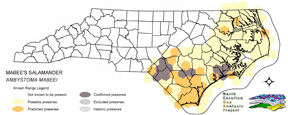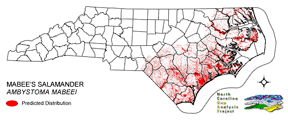
| Taxa: |
| Order: |
| Family: |
| Amphibia |
| Caudata |
| Ambystomatidae |
| NatureServe Global Rank: |
| NatureServe State (NC) Rank: |
| G4 |
| S3 |
| Federal Status: |
| NC State Status: |
| --- |
| SR |


| Land Unit |
| US Fish & Wildlife Service |
| US Forest Service |
| US National Park Service |
| US Department of Defense |
| NC State Parks |
| NC University System |
| NC Wildlife Res. Com. |
| NC Forest Service |
| NC Div. of Coastal Mgmt. |
| Local Governments |
| Non-Governmental Org. |
| Other Public Lands |
| Private Lands |
| GAP Status 1-2 |
| All Protected Lands |
| Statewide |
| Hectares |
| 59,712.21 |
| 44,043.48 |
| 51,193.17 |
| 76.14 |
| 8,144.64 |
| 18,589.77 |
| 51,297.30 |
| 7,703.64 |
| 2,524.50 |
| 90.81 |
| 15,626.25 |
| 400.41 |
| 882,268.38 |
| 138,513.69 |
| 258,845.76 |
| 1,141,670.70 |
| Acres |
| 147,552.06 |
| 108,833.79 |
| 126,501.05 |
| 188.15 |
| 20,125.84 |
| 45,936.31 |
| 126,758.36 |
| 19,036.11 |
| 6,238.17 |
| 224.40 |
| 38,613.30 |
| 989.43 |
| 2,180,132.22 |
| 342,274.72 |
| 639,621.68 |
| 2,821,129.19 |
| % of Dist. on |
| Prot. Lands |
| 23.1 % |
| 17.0 % |
| 19.8 % |
| < 0.1 % |
| 3.1 % |
| 7.2 % |
| 19.7 % |
| 3.0 % |
| 1.0 % |
| 6.0 % |
| 6.0 % |
| < 0.1 % |
| < 0.1 % |
| 53.5 % |
| ----- |
| ----- |
| % of Dist. on |
| All Lands |
| 5.2 % |
| 3.9 % |
| 4.5 % |
| < 0.1 % |
| 0.7 % |
| 1.6 % |
| 4.5 % |
| 0.7 % |
| 0.2 % |
| < 0.1 % |
| 1.4 % |
| < 0.1 % |
| 77.3 % |
| 12.1 % |
| ----- |
| ----- |
|
This salamander is an uncommon to locally common resident of the coastal plain (Wilson 1995). In bottomland areas, both conifer and deciduous forests are apparently used (Harrison 1978, Behler and King 1979). Adults usually remain near breeding water bodies (Petranka 1998). They can sometimes be found buried at the bottom of dried seasonal pools (Hardy 1969). Water bodies that contain fish are less favorable for offspring survival than are fish-free waters (Wilson 1995). Therefore, small water bodies and seasonal ponds are often used for breeding. NATURE SERVE GLOBAL HABITAT COMMENTS: Tupelo and cypress bottoms in pine woods, open fields, and lowland deciduous forest (Behler and King 1979). Pine savannas, low wet woods, and swamps (Martof et al. 1980). Usually in burrows near breeding ponds. Eggs are attached to submerged plant material or bottom debris of acidic, fishless ponds in or near pine stands (Behler and King 1979). In Virginia, breeds in fish-free vernal pond in a large clearcut area and in ephemeral sinkhole ponds up to 1.5 m deep, within bottomland hardwood forest mixed with pine (Mitchell 1991). Larvae develop in the ponds. |
| Code | Name | Description | NC Natural Heritage Program Equivalent |
| 50 | Coastal Plain Mixed Bottomland Forests | Includes forests dominated by a variety of hardwood species, including sweetgum, cottonwood, red maple. | Coastal Plain Bottomland Hardwood (in part), Coastal Plain Levee Forest |
| 49 | Coastal Plain Oak Bottomland Forest | Bottomland forests dominated by deciduous oak alliances. Oaks represented can include swamp chestnut, cherrybark, willow, and/or overcup oak. Inclusions of loblolly pine temporarily flooded forests occur in patches. Hydrology is temporarily to seasonally flooded. | Coastal Plain Bottomland Hardwoods (in part) blackwater subtype, brownwater subtype |
| 15 | Seepage and Streamhead Swamps | Includes extensive peat flats in the coastal plain, dominated by swamp tupelo, maples, and Atlantic white cedar alliances. In the sandhills includes streamhead pond pine and bay forests alliances. Saturated hydrology. | Bay Forest, Small Depression Pocosin, Streamhead Atlantic White Cedar Forest, Streamhead Pocosins |
| 30 | Cypress-Gum Floodplain Forests | Swamps dominated by black or swamp tupelo with or without Taxodium. Seasonally to semi-permanently flooded hydrology. | Cypress-Gum Swamps |
| 78 | Pond-Cypress - Gum Swamps, Savannas and Lakeshores | Cypress dominated swamps and lakeshores. Can include bays dominated by pond cypress or shorelines of coastal plain lakes with a narrow band of cypress. | Non-riverine Swamp Forest, Natural Lakeshores (in part) |
| 385 | Oak Bottomland Forest and Swamp Forest | The swamp chestnut oak, cherrybark oak, shumard oak and sweetgum alliance is one representative. Other alliances are dominated by water, willow, and overcup oaks. Swamp forests can be dominated by sweetgum, red maple, and black gum being dominant. Loblolly can occur in combination with sweetgum and red maple, or with tulip poplar. Includes saturated and semi- to permanently flooded forests in the mountains. | Piedmont/Mountain Bottomland Forest, Piedmont/Mountain Swamp Forest |
| 87 | Pocosin Woodlands and Shrublands | Includes pond pine woodland, low pocosin and high pocosin shrub dominated areas. Canebrakes and bay forests may be present. | Pond Pine Woodlands, Peatland Canebrake, Small Depression Pocosin |
| 67 | Wet Longleaf or Slash Pine Savanna | Wet flatwoods and pine savannas, typically dominated by longleaf pines, but slash or pond pines may be the dominant pines. | Wet Pine Flatwoods |
| 97 | Mesic Longleaf Pine | Longleaf pine woodlands without a major scrub oak component. Slash or loblolly pines may be present as well. | Mesic Pine Flatwoods |
| 384 | Piedmont/Mountain Mixed Bottomland Hardwood Forests | Includes temporarily to seasonally forests dominated by hardwood species. Hardwoods include sweetgum, red maple, sycamore which co-occur in a mosaic of bottomland and levee positions. Includes alluvial hardwood forests in the mountains. Hemlock and white pine may occur as inclusions, but are generally mapped separately. | Piedmont/Mountain Alluvial Forest, Piedmont/Mountain Levee Forest |
|
Kraus, F. 1988. An empirical evaluation of the use of the ontogeny polarization criterion in phylogenetic inference. Systematic Zoology 37:106-141.
Jones, T. R., A. G. Kluge, and A. J. Wolf. 1993. When theories and methodologies clash:a phylogenetic reanalysis of the North American ambystomatid salamanders (Caudata:Ambystomatidae). Systematic Biology 42:92-102. Harrison. 1978. Amphibians. in An annotated checklist of the biota of the coastal zone of South Carolina. R.G. Zingmark (ed.),Columbia, SC: Belle W. Baruch Institute for Marine Biology and Coastal Research, Univ. South Carolina. Petranka, J. W. 1998. Salamanders of the United States and Canada. Washington DC: Smithsonian Inst. Press. Zwank, P. J., and B. W. Layton. 1989. Black rats as potential Puerto Rican parrot nest predators. Caribbean J. Sci. 25:13-20. Behler, J. L., and F. W. King. 1979. The Audubon Society field guide to North American reptiles and amphibians. Alfred A. Knopf, New York. 719 pp. Martof, B. S., W. M. Palmer, J. R. Bailey, and J. R. Harrison, III. 1980. Amphibians and reptiles of the Carolinas and Virginia. University of North Carolina Press, Chapel Hill, North Carolina. 264 pp. Hardy, J. D., Jr. 1969. Reproductive activity, growth and movements of AMBYSTOMA MABEEI Bishop in North Carolina. Bull. Maryland Herpetol. Soc. 5:65-67. Hardy, J.D., Jr. and J.D. Anderson. 1970. AMBYSTOMA MABEEI Cat. Amer. Amphib. Rept. 81.1-81.2. Mitchell, J. C. 1991. Amphibians and reptiles. Pages 411-76 in K. Terwilliger (coordinator). Virginia's Endangered Species:Proceedings of a Symposium. McDonald and Woodward Publishing Company, Blacksburg, Virginia. |
For more information please contact them at:
NC-GAP Analysis Project
Dept. of Zoology, NCSU
Campus Box 7617
Raleigh, NC 27695-7617
(919) 513-2853
www.basic.ncsu.edu/ncgap